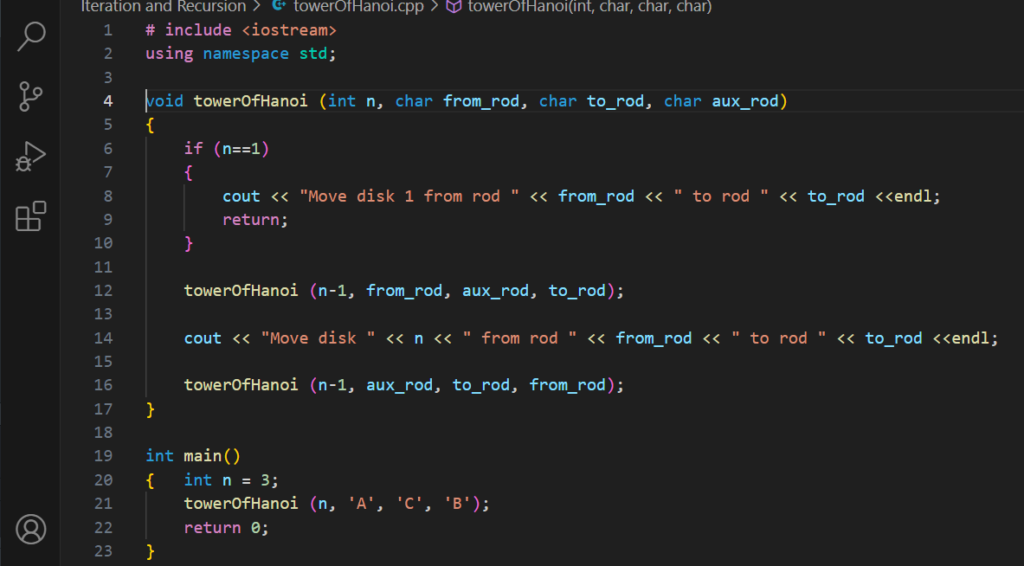🧠 1. What is Backtracking?
Backtracking is a problem-solving technique used to build up a solution incrementally and remove those solutions that fail to meet the problem constraints (i.e., “backtrack”).
Backtracking is like trying all possibilities, but avoiding wrong paths early.
🔑 Key Idea:
Try → If it fails → Undo → Try next option.
Imagine a maze:

- You go forward…
- If you hit a wall (wrong path), you backtrack (go back) to the previous step.
- Then try another path.
Backtracking is:
Try → Check → If invalid → Undo → Try next
🗼 2. Tower of Hanoi
Tower of Hanoi is a classic recursion and backtracking example.
🧩 Problem Statement:
- You have 3 rods and n disks.
- Move all disks from Source (A) to Destination (C) using an Auxiliary (B) rod.
- Rules:
- Only one disk can be moved at a time.
- A larger disk cannot be placed on top of a smaller disk.

✅ C++ Implementation

#include <iostream>
using namespace std;
void towerOfHanoi(int n, char from_rod, char to_rod, char aux_rod){
if (n == 1)
{
cout << "Move disk 1 from rod " << from_rod << " to rod " << to_rod << endl;
return;
}
// Move top n-1 disks from source to auxiliary
towerOfHanoi(n - 1, from_rod, aux_rod, to_rod);
// Move remaining disk to destination
cout << "Move disk " << n << " from rod " << from_rod << " to rod " << to_rod << endl;
// Move n-1 disks from auxiliary to destination
towerOfHanoi(n - 1, aux_rod, to_rod, from_rod);
}
int main(){
int n = 3; // Number of disks
towerOfHanoi(n, 'A', 'C', 'B'); // A = source, C = destination, B = auxiliary
return 0;
}








🧾 Output for n = 3:
cssCopyEditMove disk 1 from rod A to rod C
Move disk 2 from rod A to rod B
Move disk 1 from rod C to rod B
Move disk 3 from rod A to rod C
Move disk 1 from rod B to rod A
Move disk 2 from rod B to rod C
Move disk 1 from rod A to rod C
🔁 How It’s Backtracking:
- It tries moving smaller disks first.
- Then comes back (“backtracks”) to move the larger ones when allowed.
- Follows all constraints by carefully undoing and redoing moves as needed.
“How does Tower of Hanoi use backtracking?”
Let’s break that down.
📌 Tower of Hanoi Rules:
- Move all disks from Rod A to Rod C.
- Only one disk can move at a time.
- A larger disk can’t be placed on a smaller one.
💡 Backtracking in Action:
Let’s say you have 3 disks on rod A: Disk 3 (bottom), 2, 1 (top).
You want to move them to rod C.
Here’s the step-by-step backtracking-like logic:
🔁 Step 1: Try Moving Smaller First
- You can’t move disk 3 first — it’s at the bottom.
- So, the algorithm tries to move the top 2 disks first (recursive step).

🔙 Step 2: Move Disk 1 → Allowed ✅
- Move Disk 1 from A → C.

🔁 Step 3: Try to Move Disk 2 → Needs Free Rod
- Move Disk 2 from A → B.

🔁 Step 4: Now, Disk 1 is blocking → Must Move It
- Move Disk 1 from C → B to make space for disk 3.

➡️ This is where backtracking happens:
- You’re undoing a previous move (moving disk 1 again) to make space for a new move.
🔁 Step 5: Move Disk 3 → A to C ✅
- Finally, you can move the biggest disk.

🔁 Step 6: Restore Earlier Smaller Disks
- Now you move disk 1 and 2 again on top of disk 3.


➡️ You’re repeating/redoing earlier steps in a new way (that’s also backtracking).
✅ How It’s Backtracking:
| Concept | Tower of Hanoi Example |
|---|---|
| Try | Try moving top disks first |
| If Blocked | You can’t move large disk → go move smaller first |
| Undo | Move small disk back to make room (e.g., 1 → C → B) |
| Try Again | Now try moving the bigger disk |
🧠 Backtracking is like:
“I can’t do this move right now, so let me go back, fix the situation, and try again — step by step.”
